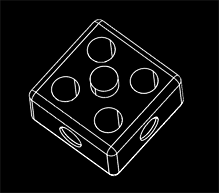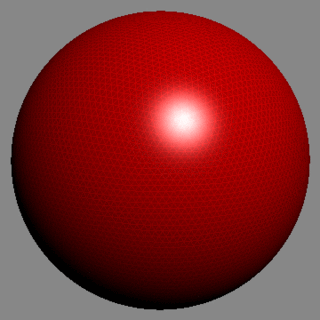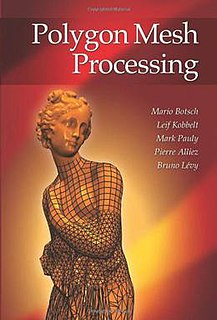In 3D computer graphics, a smoothing group is a group of polygons in a polygon mesh which should appear to form a smooth surface. [1] Smoothing groups are useful for describing shapes where some polygons are connected smoothly to their neighbors, and some are not. For example, in a mesh representing a cylinder, all of the polygons are smoothly connected except along the edges of the end caps. One could make a smoothing group containing all of the polygons in one end cap, another containing the polygons in the other end cap, and a last group containing the polygons in the tube shape between the end caps.

3D computer graphics or three-dimensional computer graphics, are graphics that use a three-dimensional representation of geometric data that is stored in the computer for the purposes of performing calculations and rendering 2D images. Such images may be stored for viewing later or displayed in real-time.
In elementary geometry, a polygon is a plane figure that is described by a finite number of straight line segments connected to form a closed polygonal chain or polygonal circuit. The solid plane region, the bounding circuit, or the two together, may be called a polygon.

A polygon mesh is a collection of vertices, edges and faces that defines the shape of a polyhedral object in 3D computer graphics and solid modeling. The faces usually consist of triangles, quadrilaterals, or other simple convex polygons, since this simplifies rendering, but may also be composed of more general concave polygons, or polygons with holes.
By identifying the polygons in a mesh that should appear to be smoothly connected, smoothing groups allow 3D modeling software to estimate the surface normal at any point on the mesh, by averaging the surface normals or vertex normals in the mesh data that describes the mesh. The software can use this data to determine how light interacts with the model. If each polygon lies in a plane, the software could calculate a polygon's surface normal by calculating the normal of the polygon's plane, meaning this data would not have to be stored in the mesh. Thus, early 3D modeling software like 3D Studio Max DOS used smoothing groups as a way to avoid having to store accurate vertex normals for each vertex of the mesh, as a strategy for computer representation of surfaces.

In the geometry of computer graphics, a vertex normal at a vertex of a polyhedron is a directional vector associated with a vertex, intended as a replacement to the true geometric normal of the surface. Commonly, it is computed as the normalized average of the surface normals of the faces that contain that vertex. The average can be weighted for example by the area of the face or it can be unweighted. Vertex normals can also be computed for polygonal approximations to surfaces such as NURBS, or specified explicitly for artistic purposes. Vertex normals are used in Gouraud shading, Phong shading and other lighting models. Using vertex normals, much smoother shading than flat shading can be achieved; however, without some modifications, it cannot produce a sharp edge.

In mathematics, a plane is a flat, two-dimensional surface that extends infinitely far. A plane is the two-dimensional analogue of a point, a line and three-dimensional space. Planes can arise as subspaces of some higher-dimensional space, as with a room's walls extended infinitely far, or they may enjoy an independent existence in their own right, as in the setting of Euclidean geometry.

In technical applications of 3D computer graphics (CAx) such as computer-aided design and computer-aided manufacturing, surfaces are one way of representing objects. The other ways are wireframe and solids. Point clouds are also sometimes used as temporary ways to represent an object, with the goal of using the points to create one or more of the three permanent representations.










